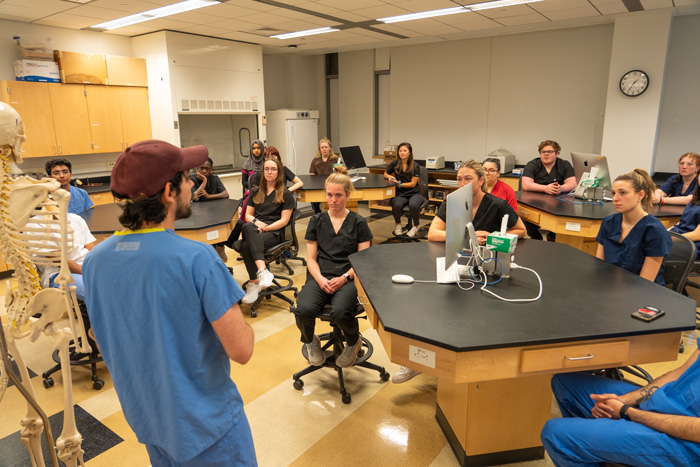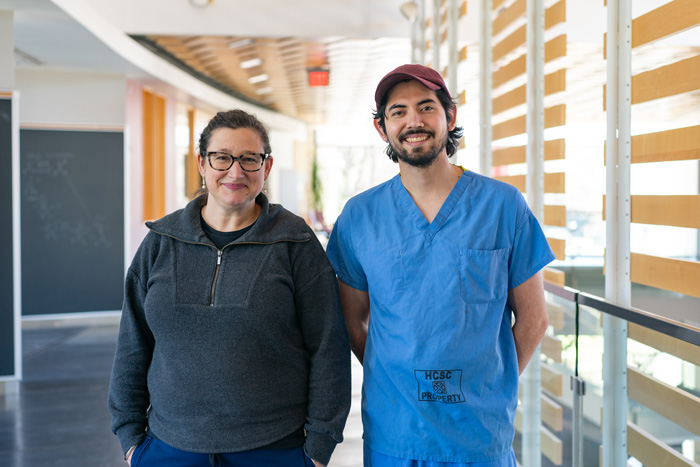Dickinson Launches Human Anatomy Course

David Diaz, lab adjunct and Ph.D. student in the anatomy program at Penn State University’s College of Medicine, leads the class. Photo by Dan Loh.
Cadaver lab fully operational for unique opportunities in the medical sciences
by Tony Moore
Dickinson is excited to announce the launch of its inaugural Human Anatomy course, a groundbreaking addition to the spring 2024 semester. This initiative grants students unprecedented access to two human cadavers, offering a rare firsthand exploration of the human body in a liberal-arts environment.
“This course was designed to model how medical and health professional schools teach human anatomy, with an emphasis on understanding anatomy from the clinical perspective,” says Associate Professor of Biology Tiffany Frey, explaining that the class is exploring one body region at a time—back, thorax, abdomen, lower limbs, upper limbs and head/neck—and integrating all systems in that region. “This is in contrast to a systems-based approach, where students learn about the skeletal, muscular, cardiovascular system and so on, one at a time.”
Through Frey, the college applied for and was approved by the nonprofit Humanity Gifts Registry to receive cadavers, which then came from Penn State College of Medicine. Now, 24 students are enrolled in the course, one that prioritizes pre-health students regardless of their major.
Lecture and Lab
In the lecture portion of class, Frey and her students brainstorm clinical anatomical issues for each area of the body and then use those ideas as examples as they build understanding of the region.
“Cadavers allow for a three-dimensional and authentic examination of the human body—no other dissection can do this,” Frey stresses, adding that while animals and digital options have their place, each has distinct drawbacks. “Also, every cadaver is different, so this allows us to emphasize diversity in anatomy and may allow students to explore unique anatomy and pathology.”
One example of this brand of in situ learning occurred when David Diaz, the lab adjunct instructor and cadaver expert for the course, discovered an indirect hernia in one of the cadavers, allowing students to see this congenital defect in real life. The other cadaver had had open-heart surgery, based on identification of tissue scarring, allowing students to detect a history of the patient from the body. Diaz uses a hands-on lab prosection approach—i.e., he prepares dissections in advance of class and uses them to demonstrate anatomical structure to students while encouraging them to manipulate and explore the cadavers.
“I give the students the ability to dissect, feel and open structures whenever possible,” says Diaz, currently a Ph.D. student in the anatomy program at Penn State University’s College of Medicine. “I feel it’s still at the level of a prosection class, but I hope eventually we can get three cadavers and actually dissect.”
Frey is also collaborating with the Department of Psychology this semester, teaming up with Assistant Professor of Psychology Ben Basile and Adjunct Faculty in Psychology Emily Brown for their Brain and Behavior w/ Lab course.
“David will remove the brains and spinal cords, which Psych 125 will use for human neuroanatomy,” says Frey, noting that Visiting Assistant Professor of Neuroscience Meredith Rauhut also has invited her Neuroscience 400 students to view the vagus nerve in the abdomen to help understand the connection between the gut and brain. “The study of human anatomy is very interdisciplinary, and we hope to expand collaboration across the curriculum in the future—particularly with courses in the arts and humanities.”

Associate Professor of Biology Tiffany Frey, who spearheaded the Human Anatomy course, with David Diaz, who helps her run it. Photo by Dan Loh.
But Is This a Unique Experience?
In short, yes. According to Frey, the Human Anatomy & Physiology Society conducted surveys on the instructional practices in anatomy and physiology laboratories in undergraduate pre-health professions in 2014 and 2016. The 2016 survey (the larger of the two) collected data from 567 participants and 470 institutions—52% from two-year colleges and 44% from four-year colleges/universities. Results indicated that only 7% use cadaver dissections and 22% use a prosected cadaver.
Frey also did benchmarking with peer and aspirant institutions during the summer of 2022 in preparation for offering her course, and only 4 of 21 peer and aspirants offer human anatomy. Of those, Frey only identified one that indicated cadaver use. And it’s this sort of exposure to anatomical forms that will set Dickinson students apart after graduation.
“Just having the experience of being in the room with human cadavers will prepare students for this emotionally challenging aspect of medical education,” says Frey, adding that the course wouldn’t be possible without donors and their families. “Our students always impress me, but they have blown me away with their ability to adapt and engage with cadaver work, and they will be better prepared emotionally and academically for graduate-level coursework and clinical experiences based on this course.”
The Student Perspective
It’s not unexpected that a course at a liberal-arts college using human cadavers would leave an imprint on students. And for those actively looking to launch a career in medicine, the benefits have been felt deeply and immediately.
“This course has proven invaluable to me, both currently and for my future pursuits,” says Saúl Torres-Nieto ’24 (biochemistry & molecular biology), who will continue his journey at Drexel University in the fall. “I’ve found the inclusion of cadaver work to be a standout feature, not commonly seen in undergraduate studies. It’s serving as excellent preparation for my upcoming doctoral studies in physical therapy, where cadaver study will be essential.”
Katie Chapis ’24 (biology), says the course has been extremely valuable, both now and in planning her future, as she plans on attending medical school a year or two down the road after focusing on clinical research once she graduates from Dickinson.
“With my interest in medicine, anatomy is a crucial content area that will be heavily focused on in medical school,” she says, noting that the small class size allows each student to interact and work with the cadavers up close, an opportunity not available at larger colleges. “It has also been extremely formative in preparing me for the knowledge and exam style I’ll need to know without the pressures of medical school.”
Ali Broome ’26 (biology) hopes to go to physician assistant school after graduating from Dickinson and notes that anatomy is a class that she’s found most programs require.
“Now that I’m able to take this class as an undergraduate, I won’t have to take a summer class or take it postgrad as I would have had to do if this class wasn't offered,” Broome says, adding that the lab component allows her to connect what she’s learning in lecture to a real human body. “Human anatomy is an important course that many prehealth students need to apply to graduate school, so now that it is offered, I think many students will take advantage of it.”
The Future of the Program and Its Students
With sufficient funding, Frey envisions expanding access to more cadavers and fostering broader collaborations across campus with departments like art, music, dance and anthropology. She’s also looking to establish a long-term partnership with the anatomy Ph.D. program at Penn State as a source of lab instructors.
“I view this as a mutually beneficial collaboration, where we get anatomy experts to teach and mentor our students and we can provide undergraduate teaching experience and mentorship to the PSU program graduate students,” Frey says. “I’m immensely grateful for the support from the provost's office and the encouragement from colleagues in the prehealth advising program, which made this dream a reality. This course has been a career aspiration of mine for years, and I'm eager to see it flourish and contribute to broader learning across disciplines.”
Frey emphasizes that getting the program off the ground was a huge team effort and would not have been possible without the support of colleagues at Penn State College of Medicine, who guided her through the process of cadaver lab setup and approval and connected her with Diaz. The huge effort paid off, and it didn’t go unnoticed by students.
Torres-Nieto calls the course “a pivotal aspect of my academic journey here.” And just as Frey is, Chapis is thankful for the experience—for all the hard work that went into developing and designing the course.
“I’m so grateful for the professors and to have the chance to learn this content at this stage in my education,” she says. “As a senior in my final semester, this course has been the cherry on top of all my wonderful biology courses here, and I am so appreciative of this experience. I’m sure it will provide a solid foundation for clinical research, medical school courses and life beyond!”
Frey would also like to thank former Provost and Dean of the College Neil Weissman for providing financial startup support for the cadaver lab and Provost and Dean of the College Renée Cramer for continued support, Ben Basile, Assistant Professor of Psychology and the Psychology Department for allowing the use a portion of his research space for the cadaver lab and the Pre-Health Professions Committee for ideas and support.
From Penn State College of Medicine, Frey thanks Patricia McLaughlin, Distinguished Professor of Neural & Behavioral Science and director of the graduate program in anatomy, and Associate Professor of Radiology and Neural/Behavioral Sciences Evan Goldman, the director of education in human structure and of the Willed Body Program. Frey also thanks Travis Finkenbinder of Finkenbinder Family Funeral Homes for donating his services for the transport of cadavers from Hershey to Carlisle.
TAKE THE NEXT STEPS
Published April 9, 2024